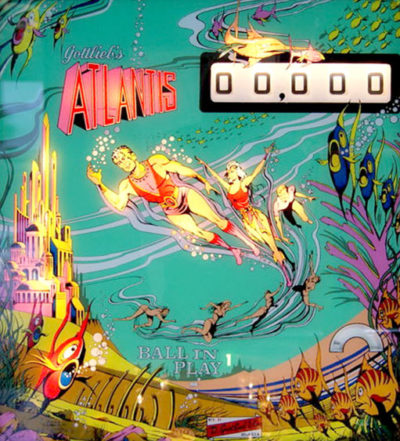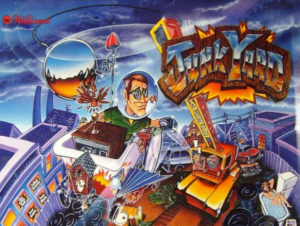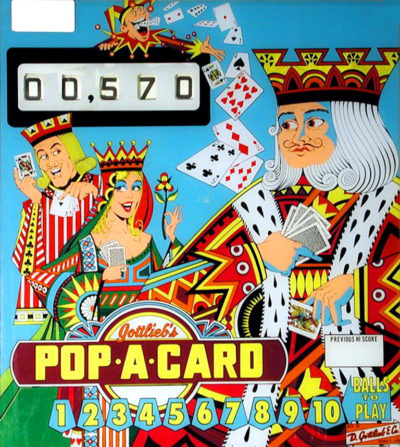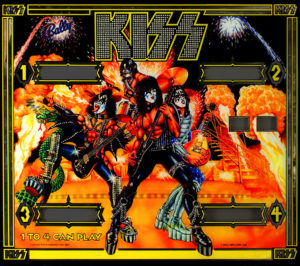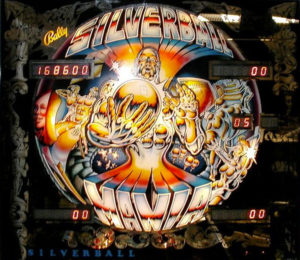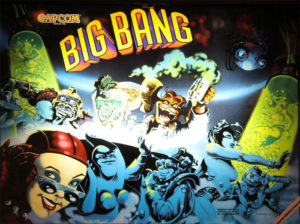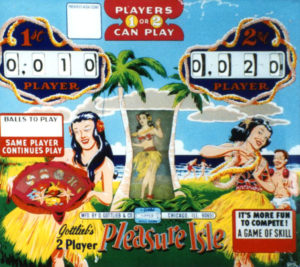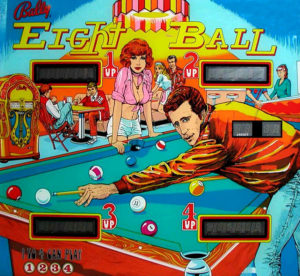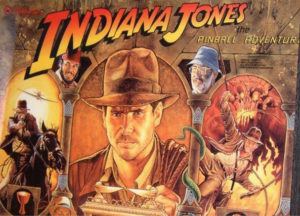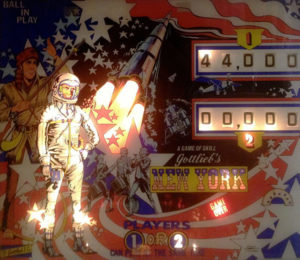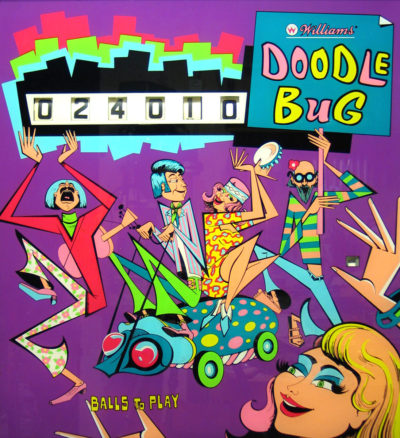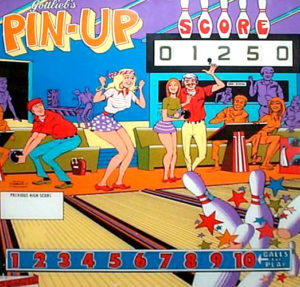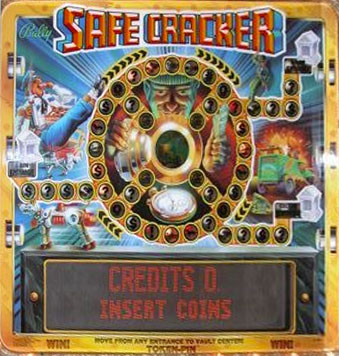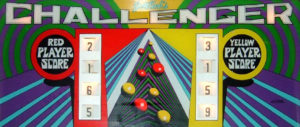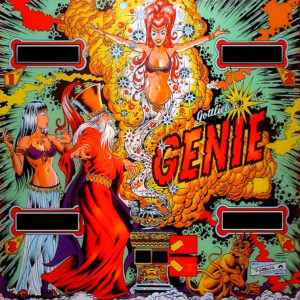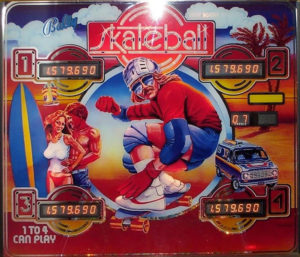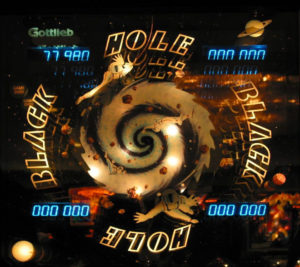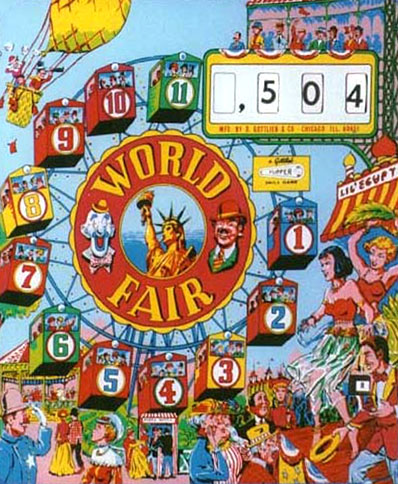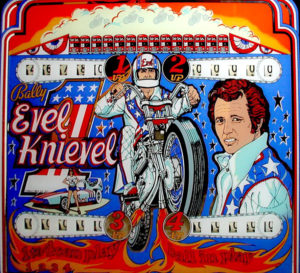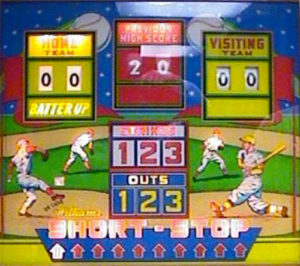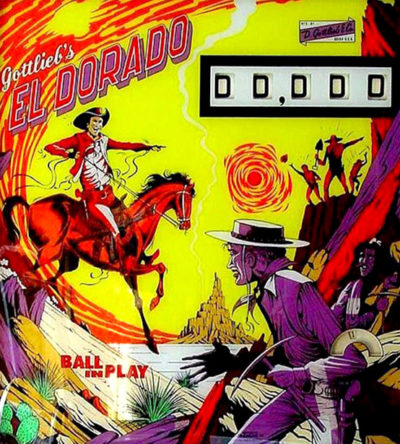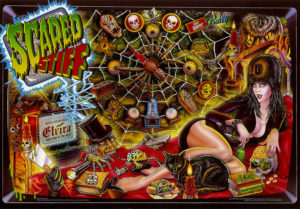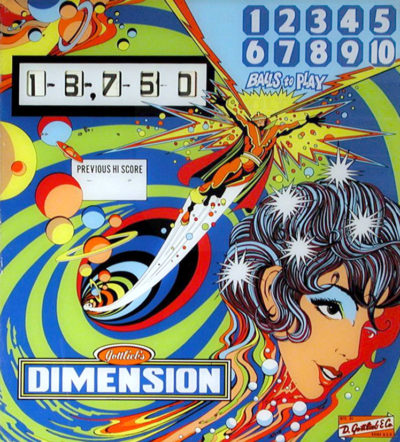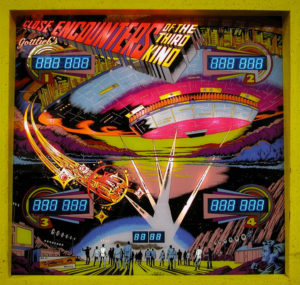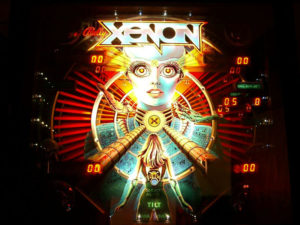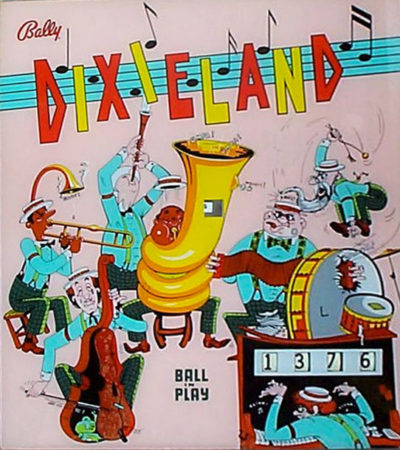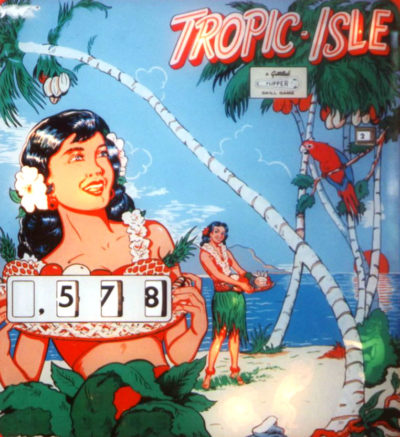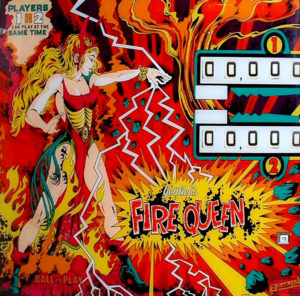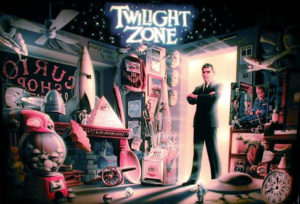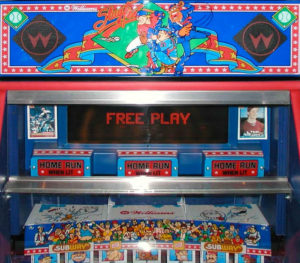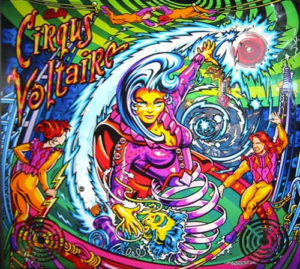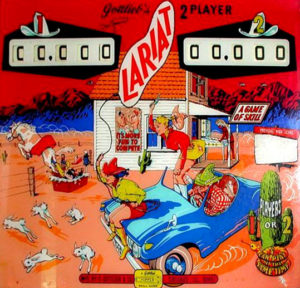-
This game by Gottlieb is a very challenging design. It was invented by Ed Krynski and artwork was drawn by Gordon Morrison. This game has 10 drop targets lined up the left side of the playfield. If one target is hit, one scores 500 points. If, however, you’re skillful enough to hit a blue and white target at the same time, 5,000 points are awarded. Completing the sequence 1-9 lights the special at the bottom left rollover as well as lights the drop targets to score a special if all the targets are dropped. The player had to be wary when trying to freeze the ball on the right flipper, as one could lose the ball up the right guide rail (which has an opening in it the size of a ball). This playfield design was used a few times by Gottlieb, as it was a successful design (games like Gottlieb 300, for example, a bowling themed game). Scoring games by core were another option.Playfield Layout There are two standard flippers and standard return lanes in the usual positions. The inlanes can be lit to start Crane Hurry-up. The outlanes have quite large openings, and each outlane can be lit separately for a “Ball Recycle”. Above the left out/inlanes there is a popper which returns the ball to the left inlane. Most of the shots that take balls under the playfield return the ball here. On the playfield beside this device is a bank of three standup targets with blue lights in the playfield in front of them, which, when completed, lights the left outlane Recycle. Above this there are two ramps with entrance side-by-side. The far left ramp leads to a toilet, which counts the spins the ball takes inside it before falling under the playfield. The inner ramp carries the ball around the back of the playfield toward a VW bus in the back right corner; a diverter can cause the ball to be temporarily held here or to return directly on a habitrail to the right inlane. This ramp also has an open side which allows slow shots to fall through to an area not otherwise accessible, which dribbles down into the hole in front of the dog. Lights in front of these ramps indicate various available shots. In the center of the top of the playfield is this game’s main feature. The “Crane” is a pinball hanging from a chain. The chain hangs from a bar (which is decorated to look like a crane) that goes into the back wall of the game. This ball can be raised or lowered, to allow the pinball to pass under it, or block its path. The bar itself can move side-to-side and up-and-down slightly, in addition to the wild motion the ball has. Around this, arranged in a semicircle, are 2 banks of 3 standup targets with an opening for another shot (which goes around a corner and under the playfield) between them. Above these there is a row of 5 larger “car” standup targets, with no gap. The crane ball can be hit into these higher targets. Several lights in front of the crane ball indicate shots available on the crane ball (by hitting it into the car standups) or in the opening behind it. There doesn’t seem to be a name for this opening (in some mode, I forget which, the game calls it the alley, but the playfield calls the DOG scoop the alley), so I will call it the center shot. Below the right side crane standups there is an up-scoop which usually drops the ball onto the bus ramp’s habitrail to the right inlane, but a diverter can send it to the dog instead. The dog is a decoration just in front of the bus; when the ball goes to him, it falls into a hole in the playfield in front of him, and if the ball was supposed to be there, a video mode starts. Lights in front of the scoop spell out D-O-G. Just to the left of it there is a small standup target, the Toaster Gun target. Below and slightly to the right of the scoop entrance, there is a sinkhole called the Sewer that can be entered from almost any direction. Lights in front of it indicate a variety of awards which can be available here, including Extra Ball and Adventures. The adventures themselves are indicated by a separate row of lights across the playfield, below the lights for the ramps, crane, and scoop. Below the Sewer there is a bank of 3 blue standups; these light the right outlane Recycle and are similar to their counterparts on the other side of the playfield. The plunger (which is a combination manual and autoplunger) shoots the ball through a spinner and into a sinkhole, which, like other holes on this game, takes the ball to the left inlane feed. Junk In the middle of the lower section of the playfield, in addition to lights for “shoot again” and autofire, there is a blueprint with 10 different pieces of junk marked with lights. Some of the pieces combine to make various contraptions. The junk consists of: Hair dryer, toaster, cuckoo clock, television, weathervane, fishbowl, propeller, fan, bathtub, and bicycle wheels. The game begins with the toaster already awarded. The combinations are: • Hair dryer + toaster = toaster gun • television + weathervane = radar • bicycle wheels + bathtub + fan = jalopy • fishbowl + jalopy = submerger • propeller + jalopy = flying machine There is an extra ball awarded for collecting a certain amount of junk, which is on a percentage; on the game I play it’s awarded on the third junk item. Collecting all the junk lets you enter your initials as junk champion at the end of the game. The current junk champion’s initials are shown on Spike’s collar when each dog video mode begins. Helpful hints At various times during the game, an angel appears on the left of the DMD or a devil appears on the right, and they make some comment. Whenever you collect junk, one or both of them appears and advises you what to collect next. (If your first junk item is anything other than the hair dryer, both appear, the angel advising you to get the hair dryer and the devil advising you to get a part for the radar.) One of these also announces each time an invention is completed, or when an adventure starts.Gottlieb Pop-A-Card was another classic ‘70s playfield designed by Ed Krynski with artwork by Gordon Morison. Only 825 of these units were made. The replay version of the game was called Drop–A-Card which, as usual, was a much higher produced machine. The open playfield of this game gives ample room for scoring the three banks of drop targets. To win free balls with this game, you have to either complete the 2, 3, 4, and 5 targets, or the 6, 7, 8, and 9 targets…or the 10, J, Q, K, and Ace targets. The first two options light the wow feature to award free balls during that ball in play. If you hit the 10 thru Ace targets to completion, four rollovers light up to score extra balls. Of course, score is another way to score more balls.This very collectible game of the ‘70s was another in a series of celebrity-themed tie-in games Bally found license to produce. 17,000 units were made, a sizable number for the day. A prototype speaking version of this game was made ahead of its time but failed to be marketed. The object of the game is to spell out the name KISS. If you complete four times, a super bonus is awarded. Do it again and a colossal bonus is awarded. A third time awards a replay and a ton of points…which can be doubled if the 2x value drop targets are completed. The A, B, C, and D targets also can award extra balls and specials. The left drop targets award the KISS line when completed. All in all, an exciting game with great graphics but no speech. Talking pinballs finally made the scene with the release of Gorgar (in the museum). Replays are also awarded by score or matching. Matching is the process by which the last two numbers of your score match the generated number produced by the game.10,350 of these machines made it through the doors of Bally in 1978. Designed by the great Jim Patla and art package by Kevin O’Conner, this early wide body machine is a perfect match for the pinball trade as well as this museum. Even though it was made prior to vocalization in pinball machines, the sounds of the machine draw one in to play its features. All the technology of the 70s is present here with drop targets, loop shots, advancing bonus features and a novel kick back kicker between the flippers which, once achieved, brings the ball back into play instead of draining. Completing the spelling of “Silverball Mania” advances the bonus features. If you complete this feat three times in a game, a built in carrier feature advances on the backglass and awards an operator-adjustable reward, classically three free games. A great playfield flow was designed into the game with two “back to the top” shots enticing players along.The last game of ’65 is a two-player add-a-ball game. It was designed by Ed Krynski with art by Roy Parker. A replay model also exists by the name of Paradise. Production run was a meager 265 units; the replay game had 2,100 units fabricated. The animated backglass on this game contains a dancing hula girl. When extra balls are won, they are represented as beach balls on the backglass. If you complete the sequence A, B, C, and D in that order, a free ball is your reward. Roto lights advance and indicate the value of the kickout holes. Points set by the operator award free balls also. An interesting guide rail is on either side of the flipper drains, a variation on a theme. This game is very rare due to its low production numbers.If you like “Happy Days” of TV fame, you’ll immediately notice “The Fonz” on the backglass. George Christian designed this machine and Paul Faris penned the artwork package. The machine was very popular in the early days of solid-state pinball. 20,230 games were made and most of them were played down to the wood subsurface under the artwork due to excessive play. The pool-themed game is set up so that players one and three’s goal is to score balls 1 to 7 and players two and four are after the 9 to 15 balls. Once completed, the eight-ball target lights. This machine has a built-in memory recall of each player’s efforts and the game continues on your next ball where you left off. Bonus awards are 3,000 points per ball lit with a holdover feature from your previous accomplishments. The right bonus lane advances the winnings by 2x, 3x, 5x , super bonus, extra balls and specials.12,716 of these Mark Ritchie-designed games were produced in wide-body format. This machine has a lot of the action associated with the first three Indiana Jones adventures produced by Lucas and Spielberg and is rated in the top 10 machines of the ‘90s. Four multiball modes grace this machine as well as a ton of video clips designed by Brian Eddy. Twelve different scenes from the movies are represented. Completing these scenes awards a six-ball multiball sequence. A three-ball multiball sequence may be had by hitting the center drop targets and popping a ball into the drop hole behind them. The path of adventure is lit by hitting the letters in the word “adventure.” Doing so opens the path up the right ramp to the tilt-a-matic playfield in the upper left. The object here is to use the flipper buttons to guide the ball to glory.This Norm Clark and Christian Marsche creation was also produced in an add-a-ball version called Love Bug as well as a four-player version called Dipsy Doodle. This symmetrical playfield design has a captive ball under the playfield which, when activated, rolls over a switch to score a bonus batch of points based on the value of the button when the feature is lit. The top kickout hole randomly selects bonus features to make the game more intriguing. A popup post between the flippers prevents ball drain down the middle of the playfield, but this post may be retracted just at the wrong time if the down-post targets are hit. An extra ball may be achieved if the center target is lit. This target also activates the “doodlebug” under the playfield. Finally, a free ball gate is incorporated into the machine if the appropriate combination of pop bumpers and rollovers are made. A fast-paced game that was popular in its day.Gottlieb hatched this add-a-ball machine from the skunkworks in April of the year, designed by Ed Krynski and artwork by Gordon Morison. This single-player machine has a bowling theme and only 715 units were produced at that time. The replay version of the game was called King Pin and many more of these machines were produced. The theme of this game is the drop target completion. By carefully aiming the four inherent flippers on board the playfield, one must try to complete the horizontal row of targets. Doing so will reset the targets and the wow feature activates, giving you a shot at the accomplishment of winning extra balls. Score is another way to pop free balls. The ten drop targets are not so easy to complete and the wow feature advances when you roll over the star rollover. This game is challenging, but a beginner can have ample fun with the machine.Safecracker is a pinball machine with a safecracking theme, designed by Pat Lawlor, and distributed by Midway (under the Bally label). It was created in 1996. About 1148 were manufactured. Safecracker differs from a standard pinball game in that the player is playing against the clock as opposed to having a certain number of balls available. If the player loses a ball, as long as there is time left on the clock they can continue playing. The machine is smaller in size than a standard pinball machine. The main objective of the game is to break into the bank’s safe. The game can be broken into 3 areas of play: The pinball playfield has numerous targets, the completion of which will allow entry into the bank via the rooftop, the cellar, or the front door. Once the player has entered the bank, the game changes to a boardgame that takes place on the backglass. Using the flipper buttons to make choices, the player rolls dice and moves their piece around the board while being chased by the security guard. The object of this portion of the game is to advance to the center of the game board (where the safe is located) before being caught by the guard. If the player is successful, the game will eject a “magic token” from the bank vault for the player to catch as it rolls down the playfield glass. After the player is done with the regular game, they can deposit their “magic token” into the token slot of the machine to activate a special game mode called “Assault on the Vault”. In this frenzied 4-ball multiball mode, players have 90 seconds to hit as many drop target and ramp shots as possible to break into the bank vault.Here is one you do not see every day. This is a Gottlieb Challenger from 1971. Only 110 of these were produced back in the day. How many are still around now … head-to-head pinball game with two players at opposite ends of the playfield, simultaneous soccer like play, can not be played with one player. Each player has flipper buttons which control only those flippers facing the opponent. Ball enters play from between the flippers. Game has 8 flippers and vertically mounted score reels. The playfield actually tilts towards and away from the players, depending on which end served the ball.This wide-body solid-state game was a high-production model with 6,800 units produced. The artwork was Gordon Morison’s creation with Ed Krynski penning the playfield. This pre-vocal machine is jam-packed with features. A mini playfield in the upper left consists of drop targets which, when completed correctly, light extra ball and special targets on the main playfield. Hitting a, b, c, and d on the top rollovers lights an extra ball feature on the mini playfield. Hitting the yellow star drop targets advances the multiplier bonus up to a 5x level. Interesting side drain configurations as well as the potential to score the kick-out hole playfield bonus prior to draining a ball is interesting. Five flippers grace the game. All in all, a great package and interesting flow for an early wide-body creation.Claude Fernandez designed this machine at Bally with the infamous Greg Freres penning the artwork early in his career. 4,150 examples of this game were screwed together. This machine’s asymmetrical playfield is classic Bally. Lane change at the top of the playfield via flipping is a first on this machine. By dropping the targets to spell “skate”, one advances the kickout hole to advance. After three or four advances, extra ball and special light. Hitting “skate” and A and B at the bottom of the playfield light extra ball. The center drop targets advance the value of the targets when all lit, all the way to 100,000 points. If you are skillful enough to advance the bonus to its highest point, the specials light up. This Bally game is also the first machine to have seven-digit scoring!This classic game is currently rated as the number two game of its generation. 4,650 units were produced in April of the year with design credits going to Roy Parker for artwork and Wayne Neyens for design. The game was produced to coincide with the New York World’s Fair of 1964-1965. The 11 ferris wheel cars depicted on the backglass are represented on the play field by roll overs and targets. Hitting a numbered car lights the corresponding backglass car. The interesting gadget developed for this game is the center spinning disc (i.e. ferris wheel) in the middle of the game. By spinning the disc, one randomly spots a ferris wheel car on the backglass. Completing all the cars awards a replay and the randomly advancing lighting of a rollover which, if you’re skilled enough, would award a replay if hit. Score is another way to conquer the machine. Enjoy trying your hand at this classic machine.(Electromechanical Version) Bally released Evel Knievel in June of the year. Both electromechanical and solid-state versions of the game were fabricated. The reason two different platforms were made was due to the newness of the solid-state platform not being fully trusted or many arcade operators not being versed in the solid-state computerized machines. The “old faithful” mechanical versions used the same technology since the beginning of pinball that included relays, steppers, and score motors. This game was produced in mass quantity in the solid-state format with 14,000 pieces being fabricated. This game is one of only 155 made. This is probably one of the best examples of this rare run of machines. The play parallels the solid-state version, but an accumulated memory of targets hit isn’t stored in memory and awarded. This game just remembers your last hit of the last target. Enjoy!Star Trek: The Next Generation is a widebody pinball game, designed by Steve Ritchie and released in November 1993 by Williams Electronics. It was part of WMS’ SuperPin series (see also The Twilight Zone and Indiana Jones: The Pinball Adventure), and was based on the TV series. It is the only pinball machine that features three separate highscore-lists. Apart from the regular highscore-list and the buy-in-list, it also features a reminiscence to The Machine: Bride of Pin*Bot billionaires club. It is also the third pinball game overall based on the Star Trek franchise, following the 1979 pinball game by Bally, and the 1991 game by Data East (both based on the original series). Launch options When a new ball is launched into the plunger, the player is given one of five launch awards, which is selected when the ball is fired. Unless otherwise noted, the ball is launched through the spiral ramp and into the lock hole (above the pop bumpers). Another ball is popped from the left scoop and onto the left inlanes. Start Mission: Starts lit mission. Flipper Skill Shot: The player has to shoot the ball up the right ramp (the Beta Quadrant) for a random award. Launch Probe: The ball will be loaded into one of the two cannons, located on top of the slings. Shoot the lit target for a random award. If the player misses, Data will say, “The probe has discovered nothing, sir”. Light Lock / Light Holodeck: Lights the ball lock, and the ball gets locked for multiball. When this option is selected twice, “Light Lock” changes to “Light Holodeck”. Warp Factor: Starts the ball at Warp Factor 4. After the player reaches Warp 9, (depending on the ROM version), the award changes to Warp 9.1, up to 9.9 (the player has only a limited amount of time to make either the left circle or Delta ramp for each point), then changes to “Warp Factor 2″. The ball is sent to the pop bumpers. Scoring and Game Modes There are several ways to score points outside of the missions as well as unlocking certain game modes. The following modes are available: Explosive Millions – Shooting the Alpha Quadrant or Beta Quadrant ramps unlocks Explosive Millions. Shooting the same or opposite ramp awards 5 million points, followed by 10 million for another shot, which cumuliates by 10 million every shot. The player has ten seconds to hit the ramp to score or the mode ends. Bonus Multipliers – Hitting all three rollover lanes above the bumpers will increase the bonus multiplier for that ball. The first completion raises it to 2X, and subsequent steps raise it 2X at a time to a maximum of 10X. When the 8X is achieved, the Extra Ball light is lit in the “Start Mission” pocket. When the multiplier is maxed, completing the rollovers again awards 10 million, with the value increasing by 10 million every time afterward Holodeck – The player has two choices. Score 25 million points, or play the “video mode” shuttle cavern. If the player selects the video mode, the player has to go through the caverns in a shuttle, picking up 10 million point cards while avoiding mines and cavern walls. There is an extra ball card somewhere in the caverns, as well as artifact (see below). Reaching the Extra Ball is achieved by alternating Left, Left, Right, Right turns until cavern 7. Depending on how many Extra Balls have already been earned and the games Extra Ball probability configuration it may end up either an Extra Ball or a 10 million point card. Once an Extra Ball has been earned in the Holodeck all subsequent Holodeck runs will not award any Extra Balls, regardless of the path chosen. Collecting the artifact, clearing all caverns, or crashing into a mine or wall immediately ends the video mode scoring the points collected in the mode. A maximum score of 159 million points is possible for a flawless run. At the start of the Holodeck mode, pressing a flipper button along with pulling the launch trigger starts a “Riker’s Poker Night” video mode. Kickback – Shooting the three left yellow targets lights Kickback, which saves the ball from draining from the left outlane. If the game is in tournament mode this must initially be earned. Otherwise the game starts out with the Kickback lit. The Kickback can be recharged unlimited times by hitting the appropriate targets after it had been depleted. Shuttle Ramp – Each shot at the Beta Quadrant Ramp launches a shuttle which a certain number of launched shuttles can reward a player. Rewards could be Light Holodeck, Command Decision, or Extra Balls. Between the ramps are two small targets when hit, adds two times the shuttle to the counter.This electromechanical two-player game was designed by Steve Kordek. The game reminds one of an older game, as an animated golfer is on board that you aim to hopefully sink a ball in the appropriate hole. The nine scattered holes are tough to sink, especially the back ones. The lower your score in strokes, the better with this game (no handicap is given). Free games may be awarded set by the operator for low-stroke counts after completing so many holes. A neat and rare game.November marks the month of this game’s release. Design was one of Ed Krynski’s and art package was penned by Gordon Morison. This game had an add-a-ball version called Gold Strike as well as a re-released solid-state version. Gottlieb also duplicated this game design in Target Alpha (in the museum) and Canada Dry. 2,875 units were produced. If you like drop targets, this is your game. A battery of 10 drop targets are in the top of the playfield and a battery of 5 on the right mid-center. Four flippers are present for aiming at your foe. If you’re skillful enough to complete all the targets, a replay is awarded, 5,000 points are added, and a special lights up to score a replay if hit. If you drain your ball, the targets reset. An advancing light under the drop targets awards 5,000 points instead of the usual 500 points if you hit the drop target when it’s up and appropriately lit. Rollovers score 5,000 points when lit. Score awards replays also as well as matching.This macabre machine was also one of the most risque games ever made. The vocals are very suggestive as well as the theme of the game. The factory installed a family mode version to the game as well as a cover to the large breasts presented by Elvira on the back glass. Designed by Dennis Nordman and Mark Weyna, the art package came out of the mind of Greg Freres. The object of the game is to complete the six modes represented on the bottom of the playfield. Once all six modes are complete, the object then is to shoot the jackpots with two balls in play all the way up the stiff-o-meter. Doing so produces a pinball fireworks show of light as well as the flippers activating by themselves. The hardest feature on the game is represented in the back glass. If you can achieve all lights by stopping the spider on each and every stop displayed, a special spider multiball is activated. Happy Halloween!This game was an “add-a-ball” game; the replay version was called 2001. Production run was 490 units. This was the first game to feature the in-line drop targets in a bank of targets. It was designed by Ed Krynski with art by Gordon Morison. A total of 20 drop targets divided into 5 targets per color. Knocking down a full left set of targets or a right set of targets awarded extra balls to be played during your current game (versus free games as the replay version awarded). The targets would reset after each ball. Extra balls were also awarded if certain scores were achieved as set by the operator. Previous high scores could be posted by the arcade on the backglass as a contest to try and beat the high score. This game was near the end of single-player Gottieb games with the smaller flippers. All in all, a classic game requiring accuracy in your shots to gain extra balls!September was the month for the introduction of this game. Both solid-state and mechanical versions were produced (9,950 versus 550 units, respectively). Ed Krynski designed the machine with art by Gordon Morison. A roto-target was incorporated into the upper right of the game, a Gottlieb exclusive. Hitting the A-B-C rollovers lights up the extra ball target and increases the value of the roto-targets as well as the drop target values. Knocking down all the drop targets increases the bonus multiplier value. The second time this feat is completed lights the special roto-target value. This game also features a bonus advance bank which increases to 20,000 points and a two to five times bonus multiplier feature. Score is the other way to win games.“Welcome to Xenon” announces the machine when you coin it up. This is the first game to incorporate a female synthesized voice as its main character. Bally produced 11,000 of these sexy, colorful games. It was designed by Greg Kmiec with art by Paul Faris. This is also the first time a game has a “vocalizer” board installed in it. Prior to this, a “squawk and talk” system was used. Finally, you can really understand the game! The playfield incorporates a right-side Xenon transport tube, which, when shot and conditions are met, lock the ball. An upper saucer at the top of the playfield not only drops one of four drop targets when rolled over, but advances the “X” value. Making three “X” completions lights the lock. The second time around awards a two-ball multiball extravaganza. Drop targets, when all four are completed, advance the bonus toward specials also. The moto exit value increases the more times the transport tube is made. A great package!Wayne Neyens designed this classic with Roy Parker penning the artwork. 2,700 of these were fabricated. This game has a holdover feature, which holds the monkeys’ positioning on the backglass from game to game. If you’re skillful enough to hit the A, B, C, and D targets, a monkey is advanced up the tree on the backglass. If one monkey makes it to the top, one replay is awarded: two monkeys score two replays, and three monkeys score three replays. Obviously if you pass this game and notice the third monkey nearing the top, feeding the coin slot was a natural for your just reward. Rolling over the 1 – 5 rollovers at the top of the playfield lights the side specials and awards 200 points once you drain the ball. A nice, well balanced game and quite a challenge not to lose your ball in play.This replay game came out in December of the year with a four-player replay version (Vulcan) being released two months prior. 970 units were produced. Ed Krynski designed the game with Gordon Morison taking the credit for artwork. Two sets of drop targets in the firing range of the flippers make for a lot of accurate target shooting. Lighting all four green drop targets lights the extra ball target. The bonus value is doubled by hitting the bank of five drop targets. Making one to five numbered sequence lights two rollovers for a special as well as increases the white drop target value to three bonus advances. The kickout hole awards from 1,000 to 5,000 points dependent on the number of green drop targets hit at that moment in time. All in all, a nicely balanced game. Bonus is awarded upon draining the ball also.This game is the most complicated solid-state pinball machine for complexity and gadgetry ever made. 15,235 of these were made and design credits go to Pat Lawlor with art by John Youssi. Multiple multi-ball options, magnets, a porcelain power ball a gumball machine and an extra-wide play field are only part of what’s before you. The main object of the game is to complete all the segments of the door in the bottom of the play field. These segments illuminate a light in the door. If by rare chance you complete the feat (you can “buy in” extra balls at the end of your game), all heck breaks loose in the form of a “lost in the zone” ultimate stage in the game. All six balls pop out, every option special, and bonus is lit all at once, and then, as if by magic, the flippers stop working (as this is a timed event) and your bonus is totaled. The battle in the zone magnet-controlled play field and power ball are neat!Official Baseball, Williams #232, 2/60, two players, woodrail with players on the playfield and animated umpire and pitcher, plus a running man unit. Uses 3/4″ balls. Very often the playfield men get broken from the ball play (or the catcher is just plain missing!) A very cool woodrail (maple side rail) baseball arcade game with hole style scoring (opposed to the 1963 and later target scoring scheme), and a very good looking game. Two player game, so competitive play is encouraged. High score is kept, with a default of 15 runs as the minimum high score to beat. Game can be set for one to three innings per game. Game uses a buzzer which sounds between innings and players. Most of the players have lights under their fielding hole. If the light is on, the runner advances if the ball goes in this hole. If the light is out, the field hole is an out. Whether the light is on or off is determined by how many players are currently on base (via the running man unit in the backbox). So hitting to the first basemen’s field hole could get the player an out or a single. Official baseball is easily the best looking of all post-WW2 pitch and bat baseballs. With the metal playfield men and classic design, it’s a handsome game. It is not though the best playing of the Williams pitch and bats. Since it does not have a home-run deck (like most of the other Williams p&b games), it’s not riveting from a game play perspective. But the pitching unit (the umpire hands the ball to the pitcher, and then the pitcher moves forward to pitch the ball).Two banks of 5 drop targets, with two kickout holes above the drop targets. Three pop bumpers, no slingshots, and two 3″ flippers. The game play/rules behind Fastdraw is rather interesting, and a bit complicated for an EM pinball. First try and score the three A-B-C rollover targets. This increases the score value of the two kickout holes (1000 points plus another 1000 for each of the scored A-B-C rollovers, for a possible 4000 points max per kickout hole). Each of the three rollovers corresponds to a pop bumper too, so scoring the “A” rollover lights its pop bumper scoring 100 points instead of 10 points. Getting the three A-B-C rollovers also turns on the “extra bonus” light (double bonus for all but the last ball). Last ball gets double bonus by default, and if the A-B-C rollover lanes are scored, triple bonus is awarded. After the A-B-C rollovers are scored, knocking down all 5 of either the right or left drop target banks will also light the corresponding right or left kickout hole for Special. (The center pop bumper alternates the Special between the right and left kickout hole.) Also each drop target knocked down increases the end-of-ball bonus by 1000 points. Finally, knocking down all 10 drop targets makes the game raise the single center black drop target on each of the two drop banks. Now this single drop target is worth 5000 points. If one of the two center black drop targets is down, again that corresponding kickout hole will alternate lit as Special (assuming the A-B-C rollovers have been scored). If both black single drop targets are knocked down, the game resets these two black drop targets again. At the end of ball all targets and features reset, so it’s rinse and repeat for the next ball/player.This game is one of the most colorful machines ever produced and it has a lot of toys to boot. 2704 of them were made and when they came out, demand was low so many sat around for years in their shipping boxes. Today it’s a top 10 collectible machine. John papadiuk designed the game with linda deal penning the artwork. Neon, disappearing pop bumper, managerie ball, magnetized ringmaster, cannon ball backglass animation and a dot matrix display embedded above the playfield are a few of its unique features. The object of the game is to complete all the playfield insert parts by defeating them. This spells out the word circus.. The ringmaster must also be completed. If you’re skillful enough to do this, you become part of the circus which brings you into 6 levels of multiball competition to complete the game. Good luck!!!
-
This game by Gottlieb is a very challenging design. It was invented by Ed Krynski and artwork was drawn by Gordon Morrison. This game has 10 drop targets lined up the left side of the playfield. If one target is hit, one scores 500 points. If, however, you’re skillful enough to hit a blue and white target at the same time, 5,000 points are awarded. Completing the sequence 1-9 lights the special at the bottom left rollover as well as lights the drop targets to score a special if all the targets are dropped. The player had to be wary when trying to freeze the ball on the right flipper, as one could lose the ball up the right guide rail (which has an opening in it the size of a ball). This playfield design was used a few times by Gottlieb, as it was a successful design (games like Gottlieb 300, for example, a bowling themed game). Scoring games by core were another option.



